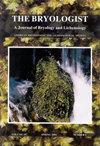北美洲和中国的两个新种,厚皮裸子藻和盘柄裸子藻(Parmeliaceae)
IF 0.8
4区 生物学
Q4 PLANT SCIENCES
引用次数: 1
摘要
摘要tuckerae是一种新描述的酸介地衣真菌,目前在俄勒冈州喀斯喀特山脉的三个地点、加利福尼亚州北部的三个地方和俄勒冈州东北部蓝山的一个地点已知。尽管多年来我们已经知道了其中一些异常的索氏体标本,但它们可能是正常繁殖物种H.wilfiana的罕见索氏体变体,或是正常索氏体地衣H.oceanica的罕见化学型,这阻碍了分类作用。ITS和GPD1序列证明两者都不是;相反,H.tuckerae在系统发育重建中占据着孤立的地位。然而,仅就ITS而言,H.tuckerae是南半球最大的地下裸子植物分支的姐妹。塔克雷的中间个体与南极H.(南美洲)、中期H.(日本)和威尔菲亚纳H.(北美)非常相似。我们还没有找到一个可靠的化学或形态学特征来分离异重迭H.tuckerae和H.wilfiana。盘状次裸子植物是我国西南地区的一个新种。该物种在本属中是不寻常的,因为它有一个pruinose末端古猿和一个POL+上皮。另一种已知具有POL+上皮的Hypogymnia是来自印度喜马拉雅山脉的结晶H。到目前为止,仅在四川省和云南省海拔3000米和3600米的两个地方发现了盘尾蠊,而且似乎很罕见。对这两个新种和最近描述的亚洲刺五加(H.caperatica),对北美洲太平洋西北部和中国西南部的地下裸子植物(Hypogymnia)的关键进行了调整。本文章由计算机程序翻译,如有差异,请以英文原文为准。
Two new species, Hypogymnia tuckerae and H. discopruina (Parmeliaceae), from North America and China
Abstract. Hypogymnia tuckerae is a newly described sorediate lichenized fungus currently known from three sites in the Cascade Range in Oregon, three sites in northern California, and one site in the Blue Mountains of northeastern Oregon. Although we have known a few of these anomalous sorediate specimens for many years, taxonomic action was stymied by possibilities that they were rare sorediate morphs of a normally fertile species, H. wilfiana, or a rare chemotype of a normally sorediate lichen, H. oceanica. ITS and GPD1 sequences demonstrated that neither is the case; instead, H. tuckerae occupies an isolated position in phylogenetic reconstructions. With ITS alone, however, H. tuckerae is sister to the largest clade of Hypogymnia species from the southern hemisphere. Esorediate individuals of H. tuckerae are very similar to H. antarctica (South America), H. metaphysodes (Japan), and H. wilfiana (North America). We have not yet found a reliable chemical or morphological character to separate esorediate H. tuckerae from H. wilfiana. Hypogymnia discopruina is described as a new species from southwestern China. The species is unusual for the genus in having pruinose apothecia and a POL+ epithecium. The only other Hypogymnia known to have a POL+ epithecium is H. crystallina from the Himalaya Range in India. So far H. discopruina is known from only two locations in Sichuan and Yunnan Provinces at 3000 m and 3600 m and appears to be rare. Adjustments to the keys to Hypogymnia in the Pacific Northwest of North America and for southwest China are given for these two new species and the recently described Asian sorediate species, H. caperatica.
求助全文
通过发布文献求助,成功后即可免费获取论文全文。
去求助
来源期刊

Bryologist
生物-植物科学
CiteScore
2.40
自引率
11.10%
发文量
40
审稿时长
>12 weeks
期刊介绍:
The Bryologist is an international journal devoted to all aspects of bryology and lichenology, and we welcome reviews, research papers and short communications from all members of American Bryological and Lichenological Society (ABLS). We also publish lists of current literature, book reviews and news items about members and event. All back issues of the journal are maintained electronically. The first issue of The Bryologist was published in 1898, with the formation of the Society.
Author instructions are available from the journal website and the manuscript submission site, each of which is listed at the ABLS.org website.
All submissions to the journal are subject to at least two peer reviews, and both the reviews and the identities of reviewers are treated confidentially. Reviewers are asked to acknowledge possible conflicts of interest and to provide strictly objective assessments of the suitability and scholarly merit of the submissions under review.
 求助内容:
求助内容: 应助结果提醒方式:
应助结果提醒方式:


